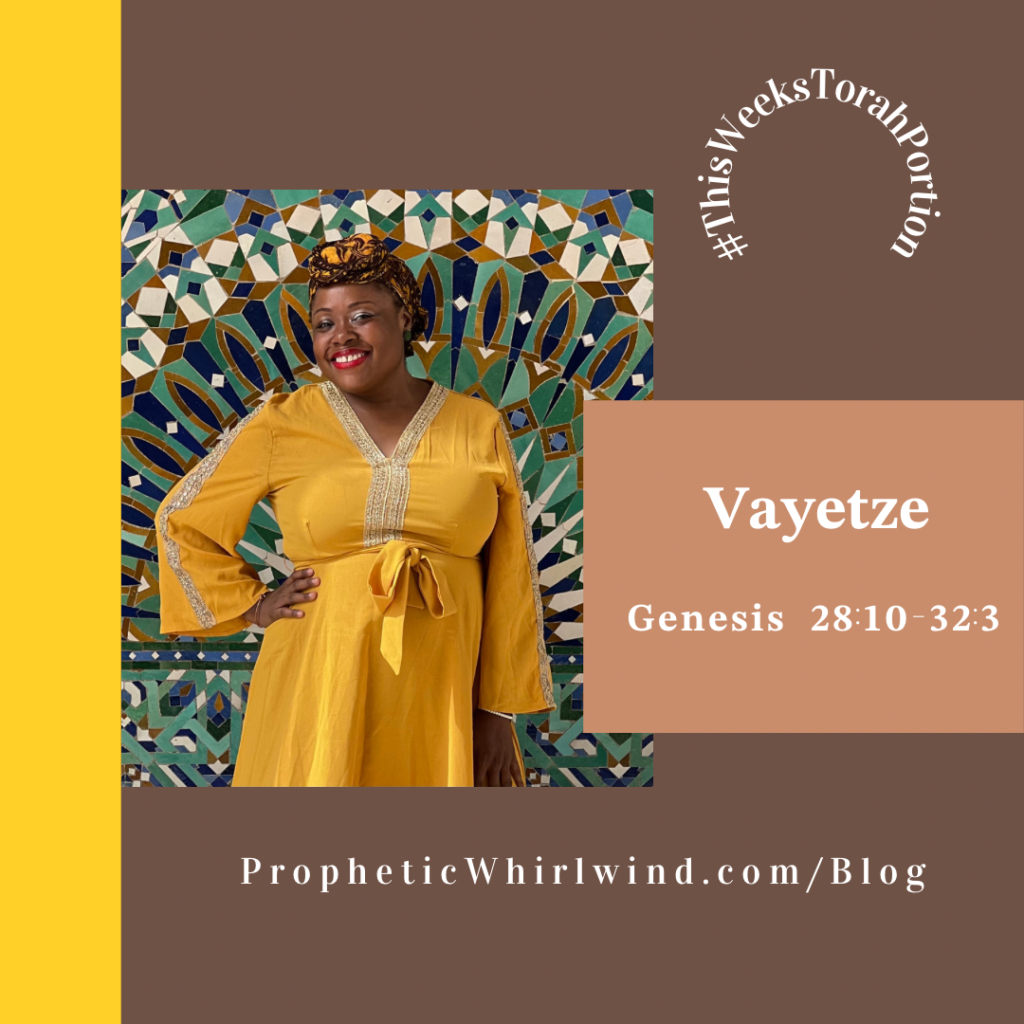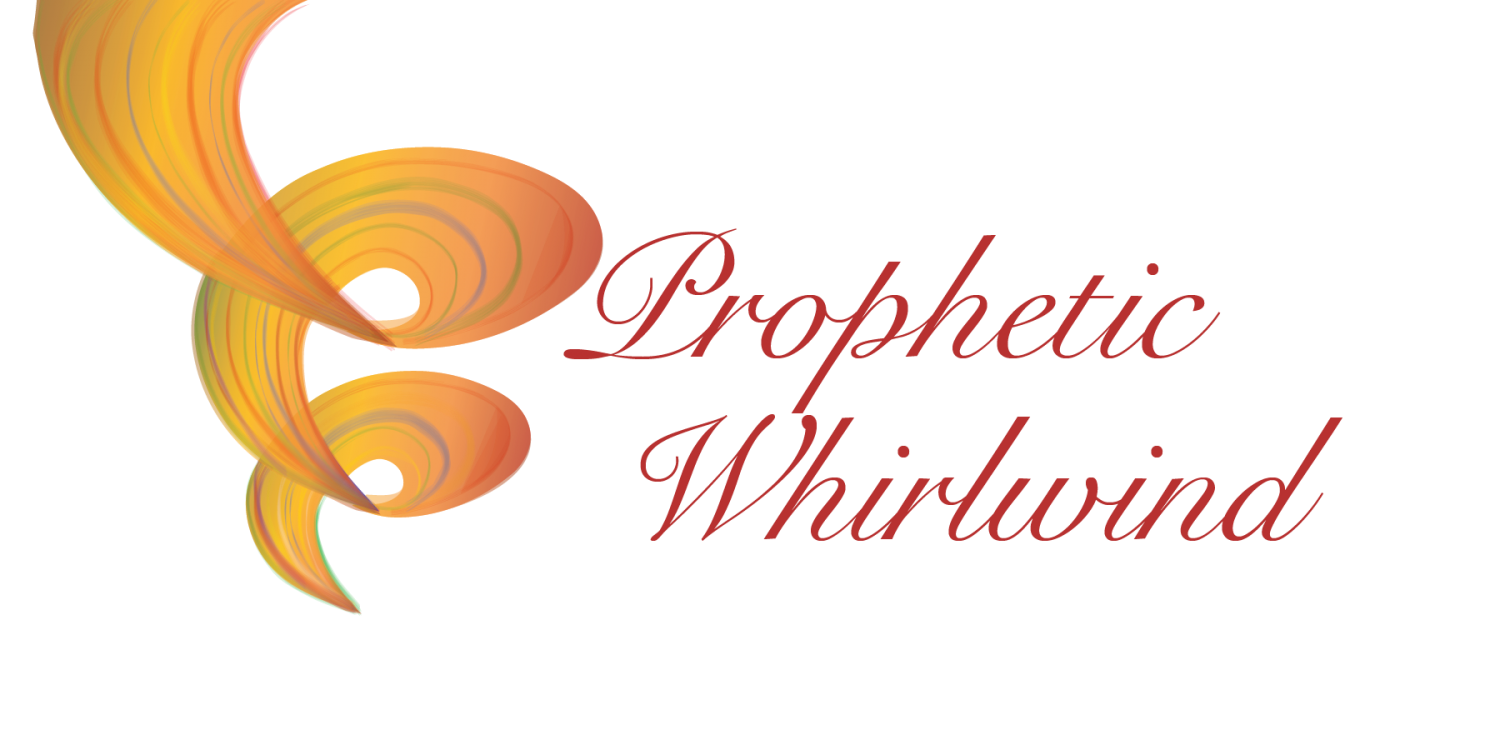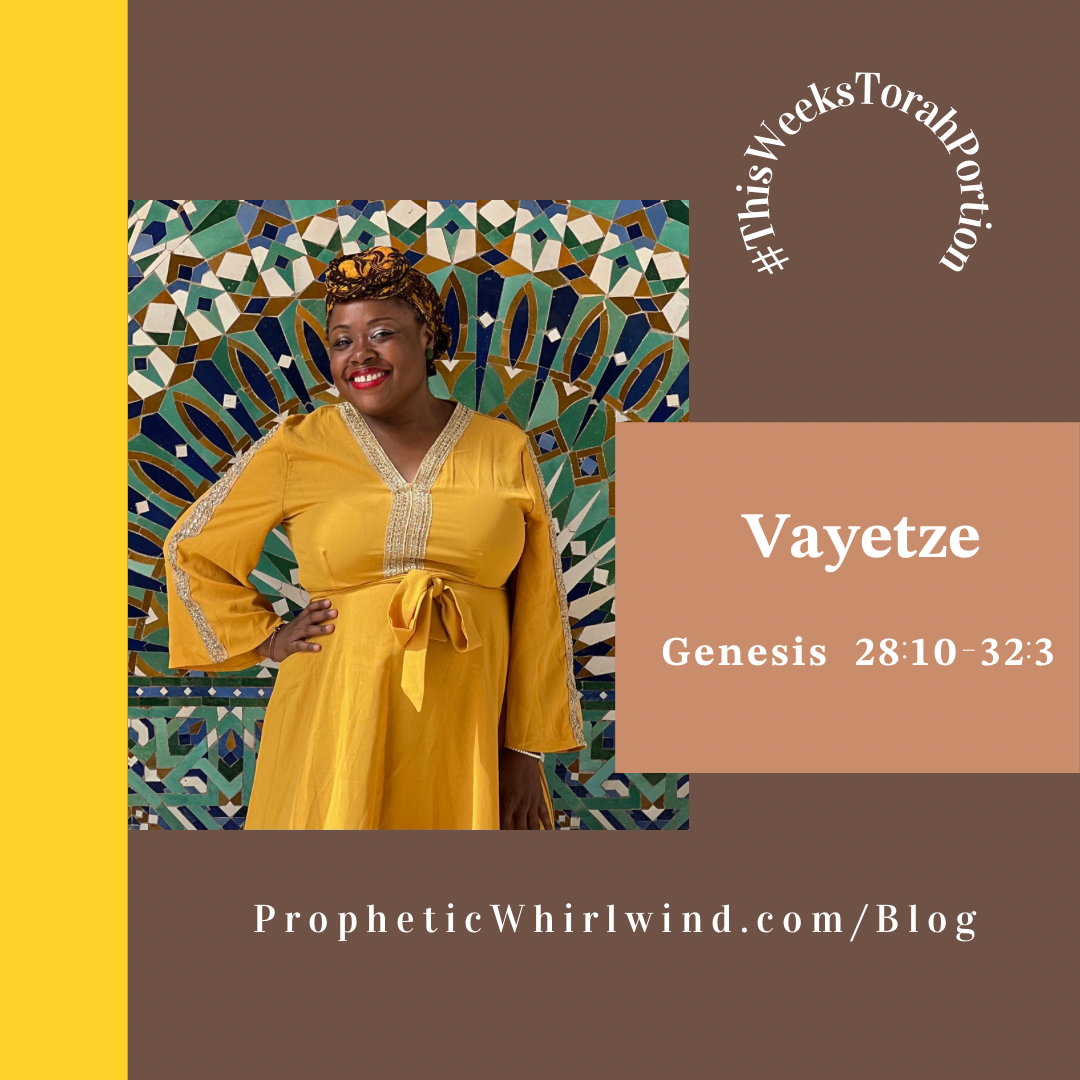𝐕𝐚𝐲𝐞𝐭𝐳𝐞 𝟐𝟖:𝟏𝟎-𝟑𝟐:𝟑

𝐕𝐚𝐲𝐞𝐭𝐳𝐞 וַיֵּצֵא— Hebrew for “and he left,” the first word in the parashah) is the seventh weekly Torah portion (פָּרָשָׁה, parashah) in the annual cycle of Torah reading. It constitutes Genesis 28:10–32:3. The parashah tells of Jacob’s travels to, life in, and return from Haran. The parashah recounts Jacob’s dream of a ladder to heaven, Jacob’s meeting of Rachel at the well, Jacob’s time working for Laban and living with Rachel and Leah, the birth of Jacob’s children, and the departure of Jacob’s family from Laban.
𝐆𝐞𝐧𝐞𝐬𝐢𝐬 𝟐𝟖:𝟏𝟎-𝟑𝟐:𝟑
🌬Jacobs ladder is featured in this week’s Torah portion. What exactly did Jacob see and experience: a literal ladder and if so to where? A pyramid? A spiral of DNA? Many have been perplexed for centuries about what exactly Jacobs Ladder was but we do know that it was prophetic. During slavery in America enslaved people sang of Jacobs ladder and some scholars say the negro spiritual “Jacob’s Ladder” cracked the code of what Jacob’s vision really meant.
“𝐖𝐞 𝐀𝐫𝐞 𝐂𝐥𝐢𝐦𝐛𝐢𝐧𝐠 𝐉𝐚𝐜𝐨𝐛’𝐬 𝐋𝐚𝐝𝐝𝐞𝐫” (also known as Jacob’s Ladder) is an African American slave spiritual based in part on the Biblical story of Jacob’s Ladder. It was developed some time before 1825. We Are Climbing Jacob’s Ladder is a spiritual. As a folk song originating in a repressed culture, the song’s origins are lost. Some academics believe it emerged as early as 1750, and definitely no later than 1825, and was composed by American slaves taken from the area now known as Liberia. The spiritual utilizes the image of Jacob’s ladder, and equates it with the body of Christ (in ways quite similar to the teachings of Catherine of Siena). The song is in the form of call and response, and although lyrics vary from place to place and over time, they generally emphasize spiritual growth, increasing one’s knowledge about Yahweh, and a call to discipleship. The striving nature of this “climb” toward God is depicted as a series of tests, and draws heavily on the New Testament tradition of the believer as warrior—in this case, overcoming the slave-owner. The traditional lyrics hold out hope that the slave can rise up and escape slavery, and the nature of the call-and-response asks both the singing respondents and the listener for greater sacrifice to reach the next level. The spiritual implies that Yahweh’s promise to the Biblical patriarch Jacob will also lead the slave to freedom.
In Genesis 28:14-15 we read of part of this promise: And thy seed shall be as the dust of the earth, and thou shalt spread abroad to the west, and to the east, and to the north, and to the south. And in thee and in thy seed shall all the families of the earth be blessed. And, behold, I am with thee, and will keep thee whithersoever thou goest, and will bring thee back into this land; for I will not leave thee, until I have done that which I have spoken to thee of.
𝐖𝐡𝐲 𝐝𝐢𝐝 𝐞𝐧𝐬𝐥𝐚𝐯𝐞𝐝 𝐩𝐞𝐨𝐩𝐥𝐞 𝐢𝐧 𝐭𝐡𝐞 𝐟𝐢𝐞𝐥𝐝𝐬 𝐟𝐞𝐞𝐥 𝐭𝐡𝐚𝐭 𝐘𝐚𝐡𝐰𝐞𝐡’𝐬 𝐩𝐫𝐨𝐦𝐢𝐬𝐞 𝐭𝐨 𝐉𝐚𝐜𝐨𝐛 𝐰𝐨𝐮𝐥𝐝 𝐥𝐞𝐚𝐝 𝐭𝐡𝐞𝐦 𝐭𝐨 𝐟𝐫𝐞𝐞𝐝𝐨𝐦?
𝐑𝐞𝐬𝐨𝐮𝐫𝐜𝐞: Listen to my thoughts on this week’s 𝐓𝐨𝐫𝐚𝐡 𝐏𝐨𝐫𝐭𝐢𝐨𝐧 𝐚𝐧𝐝 𝐓𝐡𝐞 𝐍𝐞𝐠𝐫𝐨 𝐒𝐩𝐢𝐫𝐢𝐭𝐮𝐚𝐥 𝐉𝐚𝐜𝐨𝐛’𝐬 𝐋𝐚𝐝𝐝𝐞𝐫 on The Practical Torah Podcast Episode 8 on Apple itunes: https://podcasts.apple.com/us/podcast/practical-torah/id1438926909?i=1000426498494
You can also listen to Episode 8 on YouTube: https://youtu.be/2_UmpuiMcKY
𝐒𝐨𝐮𝐫𝐜𝐞: Wimbush, Vincent L.; Rodman, Rosamond C. (eds.). African Americans and the Bible: Sacred Texts and Social Textures. Eugene, Ore.: Wipe & Stock. pp. 389–390. ISBN 9781610979641.
𝐋𝐞𝐭’𝐬 𝐫𝐞𝐚𝐝 𝐭𝐡𝐢𝐬 𝐰𝐞𝐞𝐤’𝐬 𝐓𝐨𝐫𝐚𝐡 𝐩𝐨𝐫𝐭𝐢𝐨𝐧.

